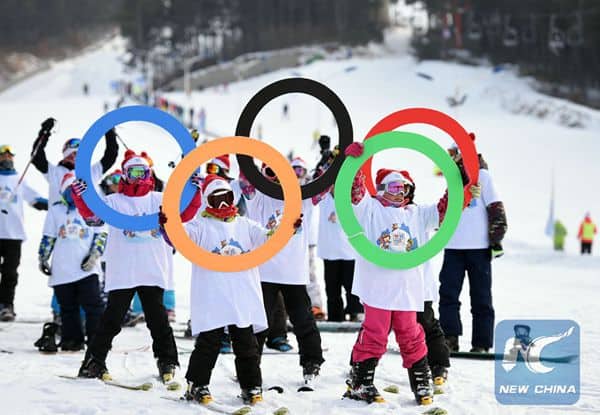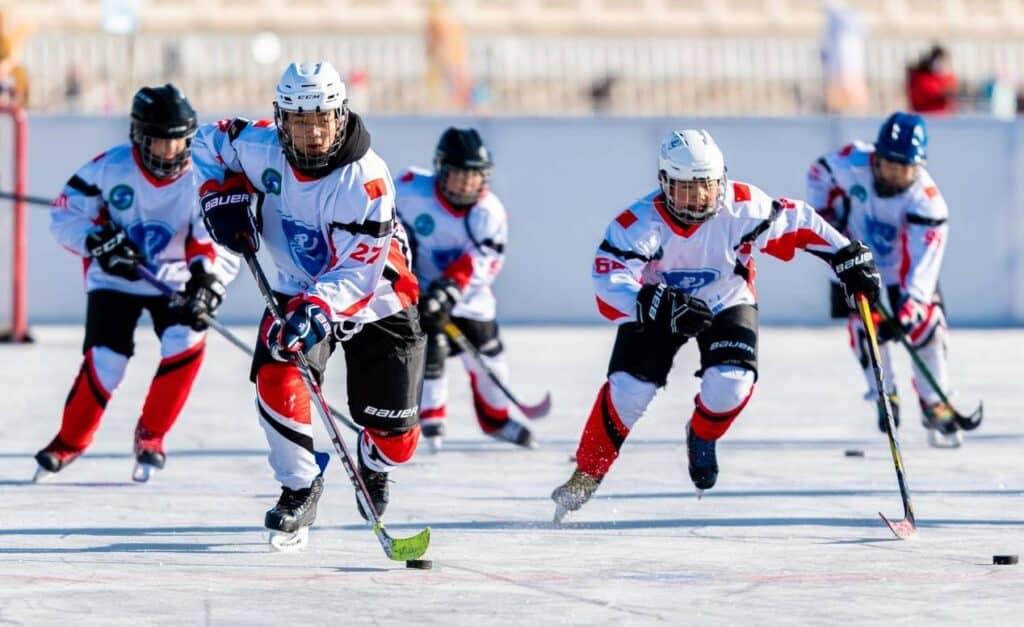Ice-Cold Revolution: China’s Winter Sports Boom
Winter Sports to Wave Riding: China’s Diverse Tourism Thrives
As the chill of winter grips North China, fostering a love for winter sports, the sunny beaches of Hainan in the south invite travelers to indulge in activities like surfing and kayaking. Across China, a distinct trend is emerging in the tourism industry — an increasing preference among tourists for experiences that meld sightseeing with sports and culture.

Tourists are increasingly seeking outdoor adventures in their travels. For instance, visitors to Hainan are embracing activities that offer a deep connection with nature. Surfing in the sea or cycling through central Hainan’s rainforests provides unique opportunities to engage with the island’s natural beauty and rich ethnic culture.
The 2022 Beijing Winter Olympics influence
The 2022 Beijing Winter Olympics marked a turning point in China’s relationship with winter sports. This global event did more than just showcase China’s organizational prowess; it ignited a nationwide enthusiasm for winter sports, democratizing these activities and integrating them into the fabric of Chinese recreational life. Here are 10 key points highlighting this transformation
China’s Snowbound Surge: A Nation Embraces Winter Games

- Olympic Catalyst: The Beijing Winter Olympics served as a catalyst, introducing a wide array of winter sports to the Chinese public and sparking interest across various demographics.
- Government Support: Post-Olympics, the Chinese government has actively promoted winter sports through investments in infrastructure and public awareness campaigns.
- Increased Accessibility: New facilities and ski resorts have made winter sports more accessible to the general public, breaking the stereotype of these activities being exclusive or elitist.
- Growing Participation: There’s been a significant increase in the number of people participating in winter sports, with skiing and snowboarding seeing the most substantial growth.
- Educational Initiatives: Schools across China are incorporating winter sports into their physical education programs, fostering early interest and skills among students.
- Local Economic Boost: The popularity of winter sports has stimulated local economies, especially in regions hosting winter sports facilities, through tourism and related industries.
- International Collaboration: China has sought expertise from countries with a strong winter sports tradition, enhancing the quality of coaching and facilities.
- Domestic Sports Brands Growth: Chinese sports brands are expanding their product lines to include winter sports equipment and apparel, further popularizing these activities.
- Media and Cultural Impact: Winter sports are increasingly featured in Chinese media and pop culture, reinforcing their growing popularity and acceptance.
- Sustainable Practices: Alongside the growth of winter sports, there’s a growing emphasis on sustainable practices to ensure environmental protection in areas hosting these activities.
The democratization of winter sports in China post-Olympics represents not just a shift in recreational habits but also signifies the country’s evolving lifestyle and cultural priorities.
Outdoor Sport industry in China
Recent reports on China’s outdoor sports industry highlight a significant surge in activities like winter sports and cycling. The post-pandemic period has seen these activities not only recover but surpass their previous popularity.

Source china-briefing
Travel platforms have noted a remarkable increase in bookings related to outdoor sports. Compared to the same period in 2019, bookings in the first half of 2023 showed a staggering rise, underscoring the growing enthusiasm for such activities. source newschina
Discussions at high-profile forums like the Boao Forum for Entrepreneurs in Hainan reflect this trend. Experts are noting an increased integration of sports and culture in tourism, a movement further fueled by events like the Beijing 2022 Winter Olympics.
Large sporting events are encouraging tourists to incorporate physical activities into their travels, seeking destinations that offer fitness-friendly options. This trend is elevating the tourism sector in various cities, as seen in Keqiao district, Shaoxing, which hosted events during the Hangzhou Asian Games, attracting thousands of spectators and boosting tourism revenue significantly.
Beyond major events, smaller-scale sports competitions are transforming lesser-known locales into sought-after destinations. For example, the village super league in Rongjiang, Guizhou province, blended soccer with Dong ethnic culture, attracting nationwide attention and significantly boosting the local economy.
Read more
Breaking the Ice: The Rise of Ice Hockey in China”
Ice hockey has seen a remarkable surge in popularity in China, emerging as a sport of growing interest and investment. Once a niche activity, ice hockey is now gaining momentum, driven by a combination of factors ranging from governmental support to international influences. This development is part of China’s broader ambition to expand its presence in winter sports, especially following the Beijing 2022 Winter Olympics.

Key Points on the Growth of Ice Hockey in China:
- Governmental Push: The Chinese government has been instrumental in promoting ice hockey as part of a larger initiative to increase participation in winter sports. This effort includes developing infrastructure, such as ice rinks, and incorporating ice sports into school curriculums.
- Rising Player Participation: There’s a growing number of both amateur and professional ice hockey players in China. Youth programs and leagues are expanding, indicating a rising interest in the sport among the younger generation.
- International Influence: The presence of professional teams, such as the Kunlun Red Star in the Kontinental Hockey League (KHL), and the participation in international competitions have raised the sport’s profile in China.
- Investment in Talent and Training: China is investing in developing homegrown talent and bringing in international coaches and players to elevate the skill level of its teams and athletes.
- Increasing Public Interest: Ice hockey is enjoying growing media coverage and public interest, with more people attending games and following the sport, signaling its rising popularity as a spectator sport.
In summary, ice hockey in China is transitioning from a relatively unknown sport to one with a growing base of players, fans, and support. This evolution reflects China’s broader ambitions in winter sports and its commitment to nurturing a diverse sporting culture.
China’s Sking Surge: Carving a Path on the Slopes
The ski industry in China has experienced a significant upswing, particularly following the 2022 Beijing Winter Olympics. Once a relatively niche pursuit, skiing has rapidly grown into a popular sport and leisure activity, attracting enthusiasts from across the nation. With substantial investments in infrastructure and a growing culture of winter sports, skiing in China is not just a trend but a burgeoning aspect of the country’s lifestyle and tourism.

Five Key Aspects of Skiing’s Growth in China:
- Olympic Boost: The Beijing Winter Olympics played a pivotal role in popularizing skiing. The event not only showcased the sport on a global stage but also inspired a new wave of interest and participation among the Chinese public.
- Infrastructure Development: Significant investments have been made in ski resorts and facilities, with the number of ski resorts and ski-related infrastructure witnessing remarkable growth. This expansion has made skiing more accessible to a broader audience.
- Rising Domestic Participation: There is an increasing trend of domestic tourists flocking to ski resorts for both recreation and sport. Skiing holidays are becoming a popular choice for families and young travelers.
- Government Support and Initiatives: The Chinese government’s push to involve 300 million people in winter sports has led to supportive policies and initiatives to promote skiing. This includes integrating skiing into school sports programs and offering incentives for the development of ski resorts.
- Growing Ski Market and Economy: The growth in skiing has spurred economic benefits, including increased tourism, job creation, and opportunities for local businesses. Ski equipment sales and ski-related tourism have become significant contributors to the local economies of ski resort areas.
In conclusion, skiing in China has transitioned from a niche sport to a significant aspect of the country’s recreational and sporting culture. With continued support and development, skiing is set to play a key role in China’s sports landscape and winter tourism economy.
Eileen Gu: China’s Skiing Prodigy and Global Sensation”
Eileen Gu, a phenomenal athlete in the world of competitive skiing, has rapidly become a household name in China and beyond. Born and raised in the United States to a Chinese mother, Gu made the bold decision to represent China in international skiing competitions. Her remarkable talent, coupled with her unique cultural background, has made her an icon in the skiing world and a symbol of cross-cultural unity.

Five Noteworthy Aspects of Eileen Gu’s Skiing Career:
- Remarkable Achievements: Eileen Gu has earned significant accolades in freestyle skiing, including medals at the Winter X Games, World Championships, and the Winter Olympics. Her victories have not only brought her fame but have also elevated China’s status in the international skiing community.
- Cultural Ambassador: By choosing to represent China, Gu has become a bridge between East and West. She is celebrated for her ability to navigate and embrace both cultures, becoming a role model for young athletes globally.
- Influence Beyond Skiing: Eileen Gu’s impact extends beyond the slopes. She has become a prominent figure in promoting winter sports among young people in China and encouraging more participation in these activities.
- Inspiring a New Generation: As a young, charismatic, and successful athlete, Gu is inspiring a new generation of skiers in China. Her success story is motivating more Chinese youth to take up skiing and pursue excellence in winter sports.
- Media and Fashion Icon: Apart from her sports career, Gu has also made a mark in the fashion and media industry. Her modeling work and media appearances have garnered a significant following, further boosting her status as a public figure and influencer.
Eileen Gu’s journey in the skiing world transcends sports; it is a story of cultural identity, national pride, and the power of following one’s passions. Her accomplishments and influence continue to shape the landscape of winter sports in China and inspire young athletes around the globe.
Read more
This fusion of tourism, sports, and culture across China is not only offering memorable experiences to visitors but also acting as a catalyst for local tourism market recovery and economic growth.
Experts emphasize the importance of continuous innovation in tourism offerings. High-quality tourism products and services are key to building a positive brand image and encouraging longer stays. Engaging stories about local history and culture, immersive experiences, trendy scenic spots, and a diverse range of tourism offerings are essential in attracting and satisfying tourists.







A lot of comments on this linkedin post about harbin Winter Sport
https://www.linkedin.com/feed/update/urn:li:activity:7146456762940887040/